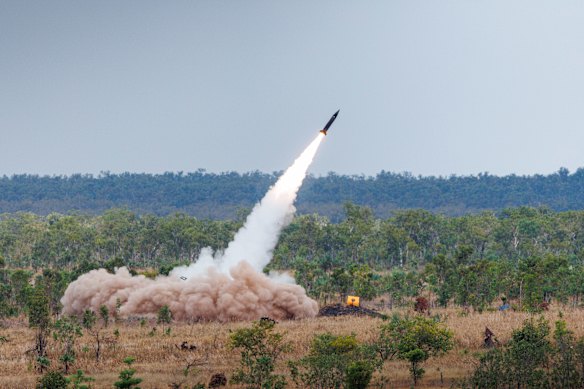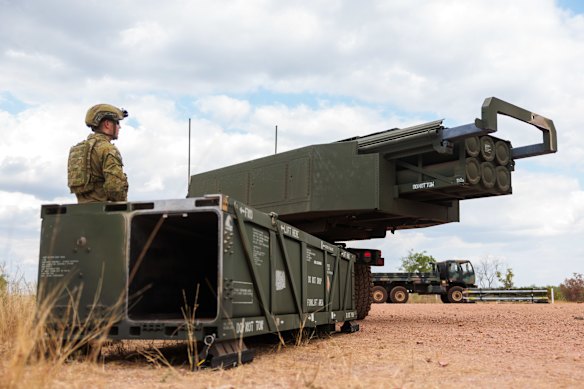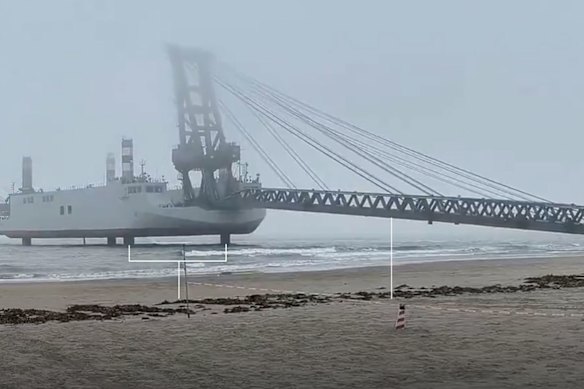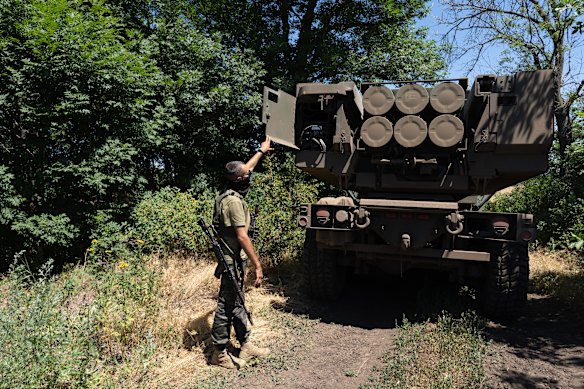By Benedict Smith
A frantic arms race between the US and China is under way in the Pacific while the fate of Taiwan hangs in the balance.
Washington and its allies are trying to stay ahead of Chinese capabilities, shaking Beijing off-balance as it considers whether it can launch a successful invasion of Taiwan.
At the heart of the US strategy is a new technology that has the ability to inflict devastating losses on the Chinese Navy: precision strike missiles (PrSMs, pronounced “prisms”).
The missile has just been tested in Australia, where it struck a target more than 305 kilometres away, marking the first time the Lockheed Martin-manufactured weapon has been used by a US ally.
It can be fired with either American-made HIMARS or British MLRS artillery systems: missile launchers that were recently used by Ukraine to launch counter-offensives on invading Russian forces and strike deep inside enemy territory, blunting Moscow’s advances.
Game-changing firepower
To date, those launchers have been used with ATACMS missiles, which have been in service for more than three decades with a top range of some 300 kilometres.
But PrSMs reportedly have a range of more than 480 kilometres, with the potential for this to improve in future variants. And at the recent test flight in Australia, the missile reached speeds of 4000km/h, beating the ATACMS by some 300km/h.

An Australian Army HIMARS fires a Precision Strike Missile (PrSM) at Mount Bundey Training Area in the Northern Territory.Credit: Defence
Each launch pod will be able to hold two of the precision missiles, compared to just a single ATACM, according to Alex Miller, the US Army’s chief technology officer. It is also said to be less susceptible to jamming.
The PrSMs combine those next-generation improvements with the advantages of the HIMARS and MLRS systems, which are quick, agile and relatively easy to disguise – and could wreak havoc on Chinese ships attempting an invasion.

The two-compartment PrSM missile launcher can be seen in the foreground of this image test-firing in the Northern Territory.Credit: Defence
Brad Bowman, a senior director at the Foundation for Defence of Democracies, said: “It really creates a challenge for our adversaries because where that system is now, it may not be there in 30 seconds or five minutes … That’s a real detection and targeting dilemma.”
Both the US and China are ramping up their military capabilities in the Pacific and particularly around Taiwan, which Beijing regards as part of its territory even though it has effectively been independent since the 1940s.
Taiwan under threat
Earlier this year, Xi Jinping, the Chinese president, said “reunification” with China was inevitable, and that those on either side of the Taiwan Strait were “one family”.
China has regularly threatened Taiwan with fighter jet and warship incursions, but has always stopped short of a direct confrontation.
At a security conference in May, Pete Hegseth, the US defence secretary, warned that a Chinese invasion of Taiwan “could be imminent”.

China recently tested bridge-making barges that could possibly be used to invade Taiwan.Credit: The New York Times
The stakes couldn’t be higher for both sides. If the US’s military capabilities are outstripped by China, it would prove fatal to Taiwan, which relies on Washington to provide a credible deterrent. And if the island nation falls, it means the loss of a key strategic buffer against Beijing’s expansionism.
But failing to take the island would inflict a stunning blow on China, and almost certainly lead to the fall of Xi’s regime.
“There’s always a constant battle with both sides to try to respond to whatever advances the other side has,” said Doug Bandow, a senior fellow with the Cato Institute.
“But I’d say these [PrSMs] have the potential for dramatically increasing the risk factor for a Chinese fleet. So that’s substantial.”
China’s military will be only too aware of the damage Ukraine has managed to inflict on Russia using HIMARS since they were first provided by the US in June 2022, and will be warily eyeing the upgraded precision missiles.
Taiwan already has 11 HIMARS from previous arms sales with the US, and it is expected to receive more in 2026.

A HIMARS system deployed in Ukraine.Credit: Washington Post
Bandow said the PrSMs will have inflicted an important psychological blow on China without any shots even being fired, and could convince its leadership to delay its imperial ambitions.
“The most important advantage of a weapons advance like this is it simply encourages the Chinese to say, ‘No … we don’t have to do it now’,” he told the London Telegraph.
“In my view, the best chance of getting through this is to simply have that happen a lot. And hopefully, we can get to a point, whatever that point is, where everyone agrees war is really stupid and this won’t happen.”
Real damage could be inflicted on the Chinese fleet, both in ports and moving out to a potential invasion, if PrSMs are deployed throughout Taiwan and the rest of the first island chain, which includes Japan, Indonesia and parts of the Philippines.
Australia aligns with the US
Elsewhere in the Pacific, Australia signed a $US310 million ($475.6 million) deal with the US to join the missile program in June.
“This is all about extending deterrence in the Indo-Pacific, all about signalling to any potential adversary that pain can be inflicted,” Australia’s Defence Industry Minister, Pat Conroy, said at the test flight this month.
But China is also moving quickly to innovate, and earlier this year, it appeared to be constructing D-Day-style barges for an invasion that would allow it to bypass rocky or soft beaches unsuitable for tanks, providing multiple fronts for an invasion.
Some experts are concerned that the US is too slow to procure PrSMs. The Pentagon’s recent funding request to Congress shows the army intends to buy 44 of the missiles from Lockheed Martin.
“There’s very rarely a decisive game changer by itself … but this is a key capability for the United States and our allies to have,” Bowman said.
“That is the ability to sink Chinese naval vessels in large quantities from ground-based mobile platforms. That’s why I think we need a whole lot of them, fast.”
The Telegraph, London
Get a note directly from our foreign correspondents on what’s making headlines around the world. Sign up for our weekly What in the World newsletter.